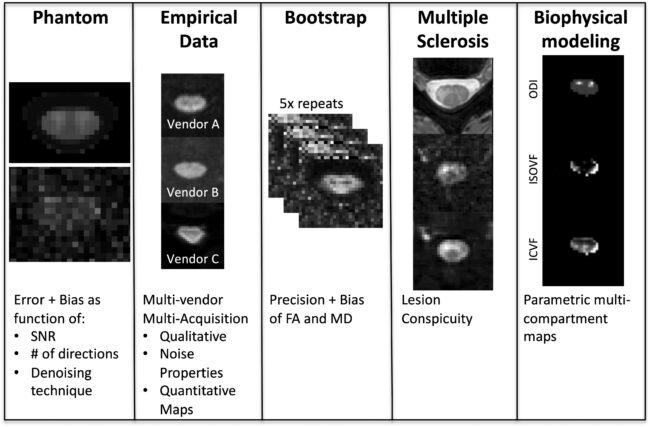Denoising of diffusion MRI in the cervical spinal cord – effects of denoising strategy and acquisition on intra-cord contrast, signal modeling, and feature conspicuity
Kurt Schilling, Shreyas Fadnavis, Joshua Batson, Mereze Visagie, Anna JE Combes, Colin D Mcknight, Francesca Bagnato, Eleftherios Garyfallidis, Bennett A Landman, Seth A Smith, Kristin P O’Grady
Paper: https://pubmed.ncbi.nlm.nih.gov/36543265/
Abstract
Quantitative diffusion MRI (dMRI) is a promising technique for evaluating the spinal cord in health and disease. However, low signal-to-noise ratio (SNR) can impede interpretation and quantification of these images. The purpose of this study is to evaluate several dMRI denoising approaches on their ability to improve the quality, reliability, and accuracy of quantitative diffusion MRI of the spinal cord. We evaluate three denoising approaches (Non-Local Means, Marchenko-Pastur PCA, and a newly proposed Patch2Self algorithm) and conduct five experiments to validate the denoising performance on clinical-quality and commonly-acquired dMRI acquisitions: 1) a phantom experiment to assess denoising error and bias; 2) a multi-vendor, multi-acquisition open experiment for both qualitative and quantitative evaluation of noise residuals; 3) a bootstrapping experiment to estimate uncertainty of parametric maps; 4) an assessment of spinal cord lesion conspicuity in a multiple sclerosis group; and 5) an evaluation of denoising for advanced parametric multi-compartment modeling. We find that all methods improve signal-to-noise ratio and conspicuity of MS lesions in individual diffusion weighted images (DWIs), but MPPCA and Patch2Self excel at improving the quality and intra-cord contrast of diffusion weighted images – removing signal fluctuations due to thermal noise while improving precision of estimation of diffusion parameters even with very few DWIs (i.e., 16-32) typical of clinical acquisitions. These denoising approaches hold promise for facilitating reliable diffusion observations and measurements in the spinal cord to investigate biological and pathological processes.
